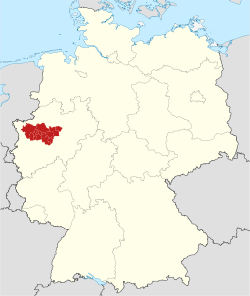Ruhr: Perbezaan antara semakan
Kandungan dihapus Kandungan ditambah
Mencipta laman baru dengan kandungan '{{Infobox settlement |name = Ruhr Metropolitan Region |native_name = <small>''Metropolregion Ruhr''</small> |image_map = Locator map...' |
(Tiada perbezaan)
|
Semakan pada 14:04, 16 Mac 2011
Ruhr, lebih tepat dipanggil daerah Ruhr atau kawasan Ruhr (bahasa Jerman German Ruhrgebiet, bahasa basahan Ruhrpott, Kohlenpott, Pott atau Revier), ialah kawasan bandar di North Rhine-Westphalia, Jerman.[3] Dengan 4435 km² dan populasi sekitar 7.3 juta (2008), ia merupakan kelompok perbandaran terbesar di Jerman. Ia mengandungi beberapa bekas bandar raya industri besar, bersempadan dengan Sungai Ruhr ke selatan, Rhine ke barat, dan Sungai Lippe ke utara. Di barat daya ia bersempadan dengan Bergisches Land. It is considered part of the larger Rhine-Ruhr metropolitan region of more than 12 million people.
Ruhr Metropolitan Region
Metropolregion Ruhr | |
|---|---|
 map of the Ruhr metropolitan region within Germany | |
| Country | |
| State | |
| Largest Cities | Dortmund Essen Duisburg Bochum |
| Pentadbiran | |
| • Badan | Regionalverband Ruhr |
| Keluasan | |
| • Metro | 4,435 km2 (1,712 batu persegi) |
| Aras tertinggi | 441 m (1,447 ft) |
| Aras Terendah | 13 m (43 ft) |
| Penduduk | |
| • Metro | 7,300,000 |
| • Kepadatan metro | 1,646/km2 (4,260/batu persegi) |
| Zon waktu | UTC+1 (CET) |
| GRP | 2007 |
| Nominal | € 136.3 billion[1] |
| Laman sesawang | http://www.metropoleruhr.de/ |
- ^ metropoleruhr.de
- ^ highest: Wengeberg in Breckerfeld, lowest: Xanten
- ^ "Few foreigners know that in fact 'the Ruhr' is the name of a 150-mile-long Rhine right-bank tributary which, after meandering through the industrial basin now named after it, enters its parent near Europe's greatest inland port, Duisburg." See German International, Volume 10 (1966), p. 30. "The territory through which the Ruhr flows is called the Ruhr district." See Edmund Jan Osmańczyk and Anthony Mango, Encyclopedia of the United Nations and International Agreements: A to F, 2003, p.1970. "Many industries were built in the Ruhr region, where both iron ore and coal were found." Kathryn Lane, Germany: The Land (2001), p. 24.